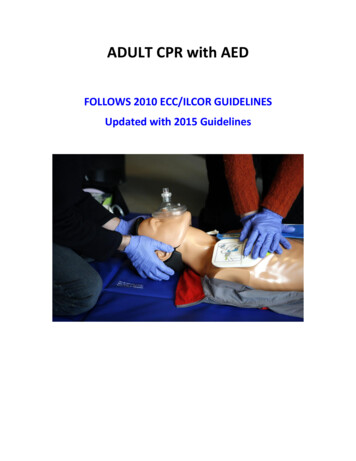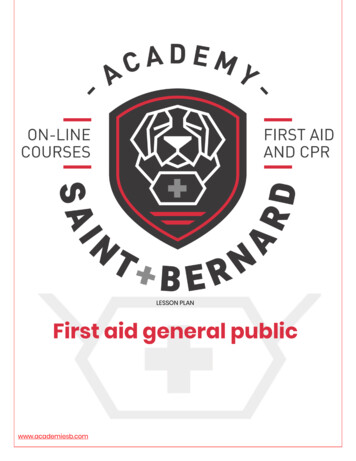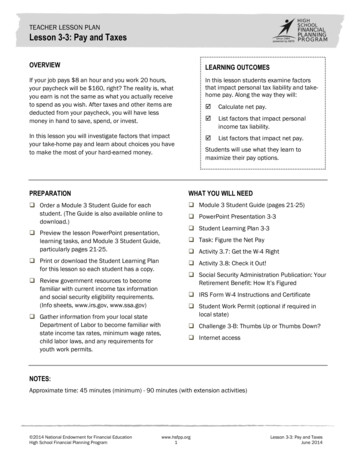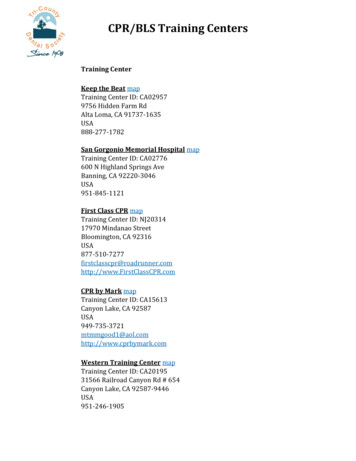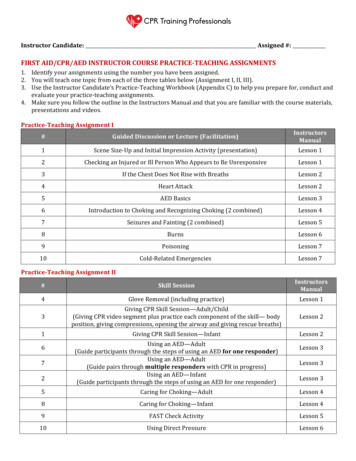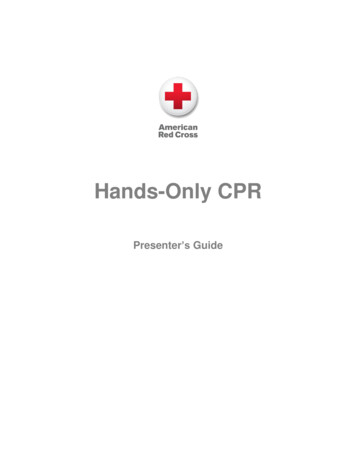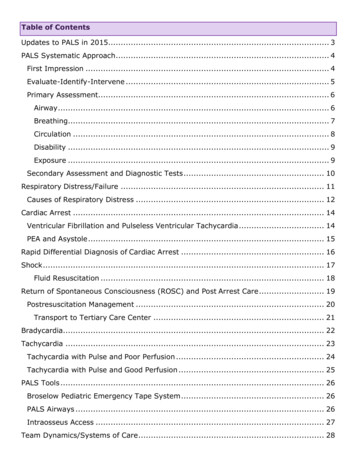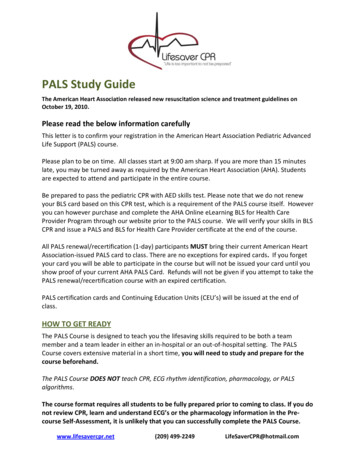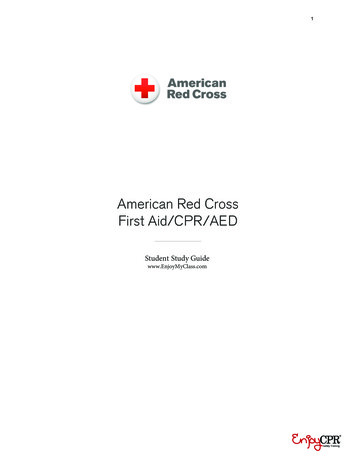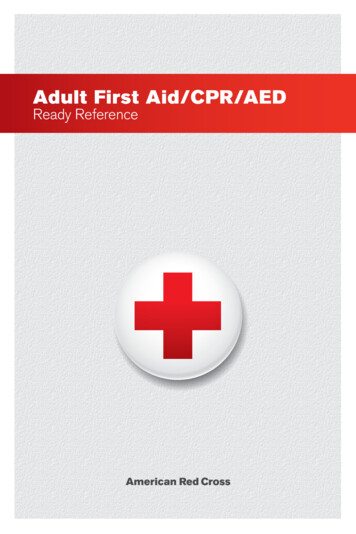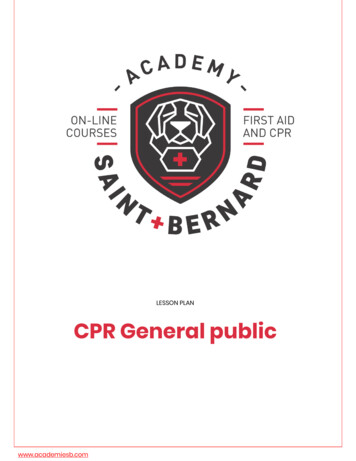
Transcription
LESSON PLANCPR General publicwww.academiesb.com
TRAINING DETAILSMODE OF INSTRUCTION:Online training using an interactive module on a web platform.TIME CONSECRATED:Course:3 hoursLaboratory and/or practical work:1 hoursPersonal work:0 hoursCRÉDITS:4 hours of trainingTRAINING VALID FOR A PERIOD OF:SCHEDULE:2 yearsOnline course: 7 days a week, 24 hours a dayThe lessons may be temporarily unavailable during your training. A notewill be posted on the main page of www.academiesb.com and/or you willreceive an email to this effect.LINK OF eral-public/COORDINATES, AVAILABILITY AND TECHNICAL il:info@academiesb.comPhone:1-866-691-09117 days a week, 24 hours a dayPlease note that a response will be sent to you within 48 hours of receivingyour message.Page - 2www.academiesb.com/en
SUMMARY1COURSE DESCRIPTION 31.1 INTRODUCTION 41.2 GENERAL OBJECTIVE OF THE COURSE 41.3 SPECIFIC COURSE OBJECTIVES 51.4 EDUCATIONNAL APPROACH 51.5 LEARNING ACTIVITIES 51.6 FRAMEWORK 62CONTENTS AND ACTIVITIES 72.1 LIST OF CONTENTS AND ACTIVITIES 72.2 DETAILED INFORMATION ON CONTENT AND ACTIVITIES 82.2.1CPR (CARDIO-RESPIRATORY RESUSCITATION) AND CRT (CHOKING RELIEF TECHNIQUE) 83EVALUATION AND RESULTS 113.1 LIST OF SUMMARY EVALUATIONS AND FORMATIVE EVALUATIONS 113.2DETAILED INFORMATION ON SUMMATIVE EVALUATIONS 123.2.1CPR (CARDIO-RESPIRATORY RESUSCITATION) AND CRT (CHOKING RELIEF TECHNIQUE) 123.3GRADING SCALE 163.4DEADLINES MANAGEMENT 163.5STUDENTS WITH DISABILITIES, LEARNING DISABILITIES OR MENTAL DISORDERS 163.6PORTABLE COMPUTER AND SOFTWARE REQUIREMENT 173.7 THE SAINT-BERNARD ACADEMY EVALUATION 174DIDACTIC MATERIAL 185MEDIAGRAPHY AND ANNEX 181 COURSE DESCRIPTIONPage - 3www.academiesb.com/en
1.1INTRODUCTIONEIGHT CARDIAC ARREST ON TEN EXTEND OUTSIDE HOSPITALSThousands of Canadians die each year from cardiac arrest because they have notreceived timely medical care. Eight out of ten cardiac arrests occur outside a hospitalcompound. They can occur in a home or public place and CPR is then performed by afirst responder in only about 15% of cases. When a cardiac arrest occurs, every secondcounts. For every minute that passes without a resuscitation maneuver, the chances ofsurvival decrease by about 10%.WHAT IS CPR?What we mean by resuscitation maneuver is the practice of CPR. But it is essential tocontact the emergency services, 9-1-1, a quick composition that saves your life.Cardiopulmonary resuscitation (CPR) is used to manually compress the heart muscleand restore blood flow to the person who suffered a cardiac arrest to keep them aliveuntil help arrives.CPR CAN QUADRUPTURE SURVIVAL RATEA pivotal study of the New England Journal of Medicine found that first responder CPR canalmost quadruple the survival rate. In addition, the quality of life of victims who havesurvived an RCO is significantly better if first responders first administered CPR before therelief arrived. By manually circulating the blood in the body, the rescuer reduces the riskof cell death. That's why it's important to be aware of CPR practices. Not only for othersbut also for you and your loved ones.1.2GENERAL OBJECTIVE OF THE COURSEThis training is used, among other things, to reduce the mortality and morbidity related tocardiopulmonary arrest (CPR) by a quick and efficient intervention of the rescuer. Theparticipant acquires the necessary skills to be able to recognize cardiovascular emergencies,have cardiopulmonary arrest, and airway obstructions in adults, children and infants. Thistraining allows the candidate to react in these various emergency situations. The trainingincludes a component on the use of the Automated External Defibrillator (AED).Page - 4www.academiesb.com/en
1.3SPECIFIC COURSE OBJECTIVESThe CPR general public course allows candidates to :-1.4Referred to section 2.2 Detailed information on contents and activities.EDUCATIONNAL APPROACHActive resolution on theoretical alternative active training, reflection, concrete and activescenarios and simulation of emergency medical situation. The training also favors aninductive pedagogical approach. Each lesson begins with an exercise or scenario for acandidate in decision, management or action. This first part often raises questions which arethen enlightened in the second part of training by a lesson. Theoretical notions of emergencymedical management will be presented in each lesson. These lessons are inspired by realitieson the ground, met by the trainers of the Saint-Bernard Academy, all health professionals. Theonline training sessions will be conducted as follows:-Exposures of the elements of skills to be mastered;-Presentation via the interactive online module of the website;-Demonstration on manikin;-Evaluation questionnaires confirming the mastery of different theories;-Exercise and situation to assimilate;-Practice at home and simultaneous theoretical contribution.IMPORTANT :The list of learning activities and evaluations that will be used during the training is shown inthe table in section 2.1 List of contents and activities.1.5LEARNING ACTIVITIESMandatory readings : No compulsory reading is required prior to the training. Precisebibliographies and readings from additional sources will be provided to allow you toassimilate concepts related to the sentations via the interactive module of our web platform: In order to explain the subject, aseries of interactive presentations have been prepared to target and understand the mainconcepts.Page - 5www.academiesb.com/en
Practical exercises :Practical exercises, simulations and simulations will make it possible toapply, in specific contexts, the theoretical concepts of the course and to put you in concretesituation of analysis and strategic reasoning.1.6FRAMEWORKThroughout your training, you can contact the Saint-Bernard Academy by e-mail, phone orFacebook Messenger. However, the preferred means of communication is e-mail (to ensurethat all participants have access to the same information and avoid duplication of responsesfrom the Academy). The Saint-Bernard Academy reads all the messages. The questions willnot be processed instantly; You will receive an answer within 48 hours.Page - 6www.academiesb.com/en
2 CONTENTS AND ACTIVITIES2.1LIST OF CONTENTS AND ACTIVITIESCPR (CARDIO-RESPIRATORY RESUSCITATION) AND CRT (CHOKING RELIEF TECHNIQUE)Title of the lessonDuration (in min.)MODULE 1 – INTRODUCTION17EVALUATION 1 – INTRODUCTION8MODULE 2 – APPROACH AND PRIMARY EXAMINATION12EVALUATION 2 – APPROACH AND PRIMARY EXAMINATION8MODULE 3 – CHEST MASSAGE15EVALUATION 3 – CHEST MASSAGE8MODULE 4 – VENTILATIONS12EVALUATION 4 – VENTILATIONS8MODULE 5 – DEFIBRILLATION9EVALUATION 5 – DEFIBRILLATION8MODULE 6 – SOME SPECIAL CASES3EVALUATION 6 – SOME SPECIAL CASES5MODULE 7 – DEMONSTRATIONS AND PRACTICES60MODULE 8 – CHOKING RELIEF TECHNIQUE9EVALUATION 7 - CHOKING RELIEF TECHNIQUE ADULTS/CHILDREN8EVALUATION 8 - CHOKING RELIEF TECHNIQUE AMONG INFANTS5TOTAL MINUTES OF TRAINING(195)3 BREAKS PERIODS RECOMMENDED(45)IMPORTANT :Take note that the duration of lessons can differ from one candidate to another due to theability of the reader to integrate the various theorems and contents taught.Page - 7www.academiesb.com/en
2.2DETAILED INFORMATION ON CONTENT AND ACTIVITIES2.2.1CPR (CARDIO-RESPIRATORY RESUSCITATION) AND CRT (CHOKING RELIEF TECHNIQUE)2.2.1.1 Module 1 – IntroductionSpecific objectives :-Know the content of the training;-Know the objectives of the training as well as the challenges related to resuscitation ofa victim in cardiorespiratory arrest;-Know the objectives of the training as well as the challenges related to the disobedienceof a victim;-Awareness of the student about the importance of CPR maneuvers;-Explain new guidelines in cardiopulmonary resuscitation and cardiac emergency care;-Awareness of the student about the different causes of a cardiorespiratory arrest;-Awareness of the student about angina and cardiac arrest;-Quickly recognize the type of victim that is being helped to provide the best possiblecare;-Awareness of the student in case of stroke.2.2.1.2 Module 2 – Approach and primary examinationSpecific objectives :-Learn to recognize dangers;-Learn to intervene effectively;-Reduce the student's stress in the event of a possible intervention;-Learn the good techniques for checking the state of consciousness;-Help with taking medication;-Learn to validate the presence or absence of a so-called effective breathing among avictim;-Learn the different techniques of turning around an unconscious victim with signs of life.Page - 8www.academiesb.com/en
2.2.1.3 Module 3 – Chest massageSpecific objectives :-Learn the good chest compressions techniques among adult;-Make the student aware of the risks and precautions related to chest compressions forsome victims;-Learn the good chest compressions techniques among children;-Learn the good chest compressions techniques among infants;-Make the student aware of the importance of the chest compressions quality.2.2.1.4Module 4 – VentilationsSpecific objectives :-Learn the good ventilations techniques among adult;-Learn the good ventilations techniques among children;-Learn the good ventilations techniques among infants;-Learn to properly ventilate through mouth-to-mouth;-Know and tame the different ventilation devices available.2.2.1.5Module 5 – DefibrillationSpecific objectives :-Learn to recognize when to use a defibrillator;-Learn the use of a defibrillator;-Learn to recognize the risks associated with the use of a defibrillator;-Learn the particularities of using a defibrillator in an infant.2.2.1.6Module 6 – Some special casesSpecific objectives :-Make the student aware of the different possible cases;-Reduce the stress of the student facing a possible intervention.Page - 9www.academiesb.com/en
2.2.1.7 Module 7 – Demonstrations and practicesSpecific objectives :-Learn good CPR techniques in adults with AED;-To control a complete intervention against a victim (adult) in cardiorespiratory arrest to 1rescuer;-Learn good CPR techniques in children with AED;-To control a complete intervention against a victim (child) in cardiorespiratory arrest to 1rescuer;-Learn good CPR techniques in infants;-To control a complete intervention against a victim (infant) in cardiorespiratory arrest to 1rescuer.2.2.1.8Module 8 – Choking relief techniqueSpecific objectives :-Learn the guidelines and the good choking relief technique among adults and children,conscious or unconscious;-Learn the guidelines as well as the good choking relief technique among multiple victims,conscious or unconscious;-To learn the guidelines as well as the good techniques of choking relief among infants.Page - 10www.academiesb.com/en
3 EVALUATION AND RESULTS3.1LIST OF SUMMARY EVALUATIONS AND FORMATIVE EVALUATIONSCPR (CARDIO-RESPIRATORY RESUSCITATION) AND CRT (CHOKING RELIEF TECHNIQUE)TITLEWORK MODEWEIGHTINGEvaluation 1 – IntroductionIndividual online12.5%Evaluation 2 – Approach andIndividual online12.5%Evaluation 3 – Chest massageIndividual online12.5%Evaluation 4 – VentilationsIndividual online12.5%Evaluation 5 – DefibrillationIndividual online12.5%Evaluation 6 – Some specialIndividual online12.5%Individual onlineN/AIndividual online12.5%Individual online12.5%primary examinationcasesDemonstrations and practiceswith 1 first-aid attendantEvaluation 7 – Choking relieftechnique among adults /childrenEvaluation 8 – Choking reliefamong infantsPage - 11www.academiesb.com/en
3.2DETAILED INFORMATION ON SUMMATIVE EVALUATIONS3.2.1CPR (CARDIO-RESPIRATORY RESUSCITATION) AND CRT (CHOKING RELIEF TECHNIQUE)3.2.1.1 Evaluation 1 – IntroductionDelivery date :You have a maximum of 10 chancesWork mode :Individual onlineWeighting :12.5%Evaluation delay :You have one hour to complete the examEvaluation guideline :You will be assessed using a multiple choice exam. Thequestionnaire will confirm that the candidate mastersthe theories present in the introduction section.Criteria for evaluating the questionnaire of the introduction :The pass mark is set at 80%3.2.1.2 Evaluation 2 – Approach and primary examinationDelivery date :You have a maximum of 10 chancesWork mode :Individual onlineWeighting :12.5%Evaluation delay :You have one hour to complete the examEvaluation guideline :You will be assessed using a multiple choice exam. Thequestionnaire will confirm that the candidate mastersthe theories present in the approach and primaryexamination section.Criteria for evaluating the questionnaire of the introduction :The pass mark is set at 80%Page - 12www.academiesb.com/en
3.2.1.3 Evaluation 3 – Chest massageDelivery date :You have a maximum of 10 chancesWork mode :Individual onlineWeighting :12.5%Evaluation delay :You have one hour to complete the examEvaluation guideline :You will be assessed using a multiple choice exam. Thequestionnaire will confirm that the candidate mastersthe theories present in the chest massage section.Criteria for evaluating the questionnaire of the introduction :The pass mark is set at 80%3.2.1.4Evaluation 4 – VentilationsDelivery date :You have a maximum of 10 chancesWork mode :Individual onlineWeighting :12.5%Evaluation delay :You have one hour to complete the examEvaluation guideline :You will be assessed using a multiple choice exam. Thequestionnaire will confirm that the candidate mastersthe theories present in the ventilations section.Criteria for evaluating the questionnaire of the introduction :The pass mark is set at 80%3.2.1.5Evaluation 5 – DefibrillationDelivery date :You have a maximum of 10 chancesWork mode :Individual onlineWeighting :12.5%Evaluation delay :You have one hour to complete the examPage - 13www.academiesb.com/en
Evaluation guideline :You will be assessed using a multiple choice exam. Thequestionnaire will confirm that the candidate mastersthe theories present in the defibrillati
WHAT IS CPR? What we mean by resuscitation maneuver is the practice of CPR. But it is essential to contact the emergency services, 9-1-1, a quick composition that saves your life. Cardiopulmonary resuscitation (CPR) is used to manually compress the heart muscle and restore blood flow to the person who suffered a cardiac arrest to keep them alive
